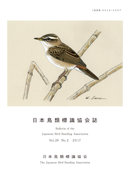All issues

Volume 29 (2017)
- Issue 2 Pages 73-
- Issue 1 Pages 1-
Volume 29, Issue 2
Displaying 1-3 of 3 articles from this issue
- |<
- <
- 1
- >
- >|
Research articles
-
Noritomo KAWAJI2017Volume 29Issue 2 Pages 73-84
Published: 2017
Released on J-STAGE: July 25, 2018
JOURNAL FREE ACCESSThe staying periods of Asian Stubtail Urosphena squameiceps, Black-faced Bunting Emberiza spodocephala, and Eastern Crowned Leaf Warbler Phylloscopus coronatus post-fledging juveniles in their natal area were estimated by banding their nestlings and recapturing the birds during autumn bird banding periods in the deciduous forest of Hokkaido Research Center, Forestry and Forest Products Research Institute, Sapporo, Hokkaido. We had 11 recaptures of juvenile Asian Stubtails. The mean elapsed period after fledging was 56 days and the longest was 76 days. This implies that this species may stay close to their natal site for approximately 2 months after fledging. Three juvenile Black-faced Buntings that fledged from same nest were recaptured. The longest stay observed was 90 days after fledging. Recapture data between study site and neighbor banding sites during the autumn migration season showed not only southerly, but also northerly and easterly directions from the release point in short periods from the release. Only one Eastern Crowned Leaf Warbler juvenile was recaptured at a location that was west-southwest from the release point and was at 32 days after fledging.View full abstractDownload PDF (917K) -
Japanese Marsh Warbler Locustella pryeri wintering in Chiba Prefecture and Lower Tone River of JapanMasao TAKAHASHI, Jun-ichi EBINA, Akio MIYA, Kazuhide ISOGAI, Takashi F ...2017Volume 29Issue 2 Pages 85-94
Published: 2017
Released on J-STAGE: July 25, 2018
JOURNAL OPEN ACCESSThe survey of wintering Japanese Marsh Warbler Locustella pryeri was conducted at 37 wet grasslands within Chiba Prefecture and Lower Tone River of the Kanto Region from late December to mid-February in three winters (2014-2017). We located 338 individuals at 27 survey sites. Abandoned rice fields were one of the most important environments: they had the most wintering sites and populations. The birds were located in various types of grassland, suggesting that they can use some vegetation structures for wintering.View full abstractDownload PDF (580K)
Observation report
-
Yuji OKAHISA, Kana YAMAMOTO2017Volume 29Issue 2 Pages 95-99
Published: 2017
Released on J-STAGE: July 25, 2018
JOURNAL FREE ACCESSA Redwing Turdus iliacus was captured in a forest at Washizaki on Sado Island on April 16, 2017. This bird was identified as the first summer plumage of subspecies iliacus according to measurements taken and its plumage characteristics. This is the first record of a Redwing in the Niigata prefecture.View full abstractDownload PDF (747K)
- |<
- <
- 1
- >
- >|